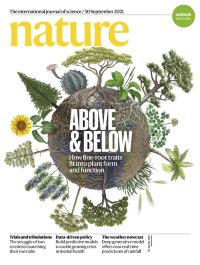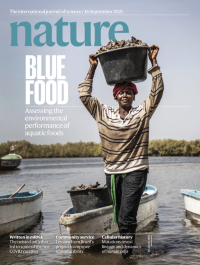Volume 597
-
No. 7878 30 September 2021
Above & belowThe traits exhibited by plants determine how they cope with their environment. In this week’s issue, Carlos Perez Carmona and his colleagues analyse the relationship between aboveground traits, such as plant height and leaf size, and the belowground traits of fine roots. They find that the aboveground functional strategy of a vascular plant does not reveal much about its fine-root strategy, so that species with very different aboveground traits can have very similar fine roots, and vice versa. Even so, the researchers also found evidence of whole-plant coordination, as demonstrated by patterns of dissimilarity and redundancy among families and biomes.
Nature Outlook
-
No. 7877 23 September 2021
Shooting the breezeThe 3D shapes of many plant seeds are optimized to aid dispersion by wind — often allowing the seeds to travel hundreds of kilometres. Taking inspiration from these aerial hitchhikers, John Rogers and his colleagues in this issue present a series of 3D macro-, meso- and microscale fliers that can similarly use wind for dispersal. The researchers were able to maintain flight times even when the fliers were weighed down with active electronic payloads. They note that one example application for the fliers could be as battery-free, wireless devices for atmospheric measurements.
-
No. 7876 16 September 2021
Blue FoodThe cover shows a woman from the TRY Oyster Women’s Association unloading oysters by the Gambia River. Aquatic foods such as fish, shellfish, and seaweed, collectively known as blue foods, show potential for reducing some adverse environmental effects of global food production. In this week’s issue, Jessica Gephart and her colleagues provide standardized estimates for a range of environmental pressures for diverse blue foods, representing about three-quarters of global production. The researchers looked at greenhouse-gas emissions, nitrogen and phosphorus pollution, and freshwater and land use. They found that farmed bivalves and seaweeds generate the lowest emissions and use the fewest land and water resources, and they identified many finfish options with low emission and resource use, both farmed and wild caught. The team also modelled ways to improve the environmental performance of blue foods, in some instances cutting emissions by half.
-
No. 7875 9 September 2021
Filling the gapsThe cover features an artist’s impression of a newly discovered lizard-like creature from the Triassic named Taytalura alcoberi. The fossil record representing reptile evolution is somewhat patchy when it comes to lepidosaurs — the group that encompasses squamates (lizards and snakes) and sphenodontians (such as tuataras). In this week’s issue, Ricardo Martínez and his colleagues help to plug the gaps with the fossilized skull of Taytalura, discovered in Argentina and dating to some 230 million years ago. The well-preserved skull represents a lineage that evolved before the split between squamates and sphenodontians, thus representing one of the earliest known lepidosaurs. The researchers note that Taytalura’s skull shares features with modern tuataras, suggesting that several anatomical features, presumed to be found only in sphenodontians, must have originated early in lepidosaur evolution.
-
No. 7874 2 September 2021
Agents of decayThe cover features the beetle Megalodacne fasciata, one of the many insect species that aids the decomposition of forest deadwood — a process that releases a sizeable amount of carbon. In this week’s issue, Sebastian Seibold and his colleagues offer an insight into exactly how much of a contribution insects make to this process. The researchers conducted field experiments at 55 forest sites across 6 continents, finding that insects accelerate decomposition in tropical forests with little effect in temperate and boreal forests. The team estimates that about 10 billion tonnes of carbon are released from deadwood globally, and that the net effect of insects accounts for about 29% of this total.





